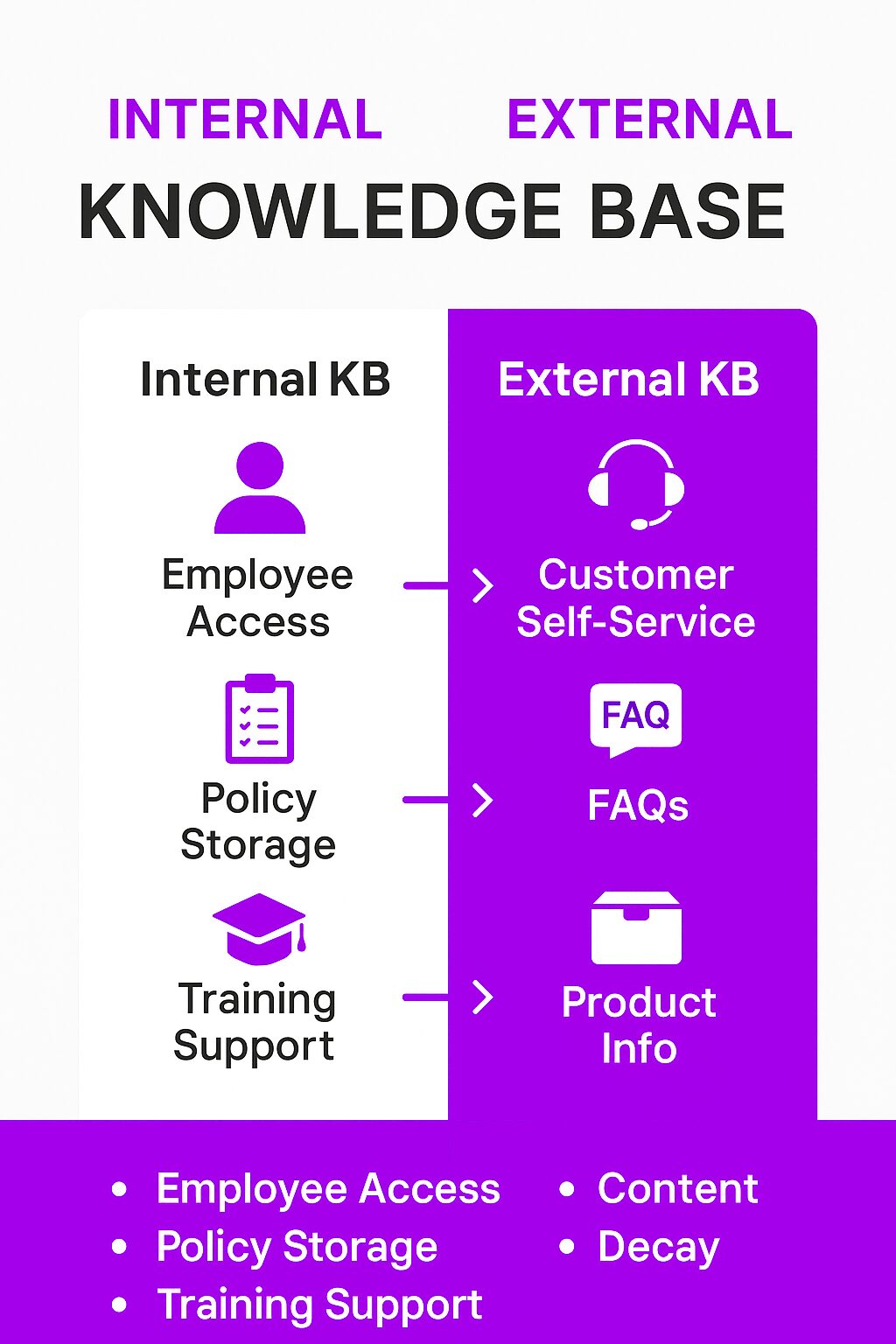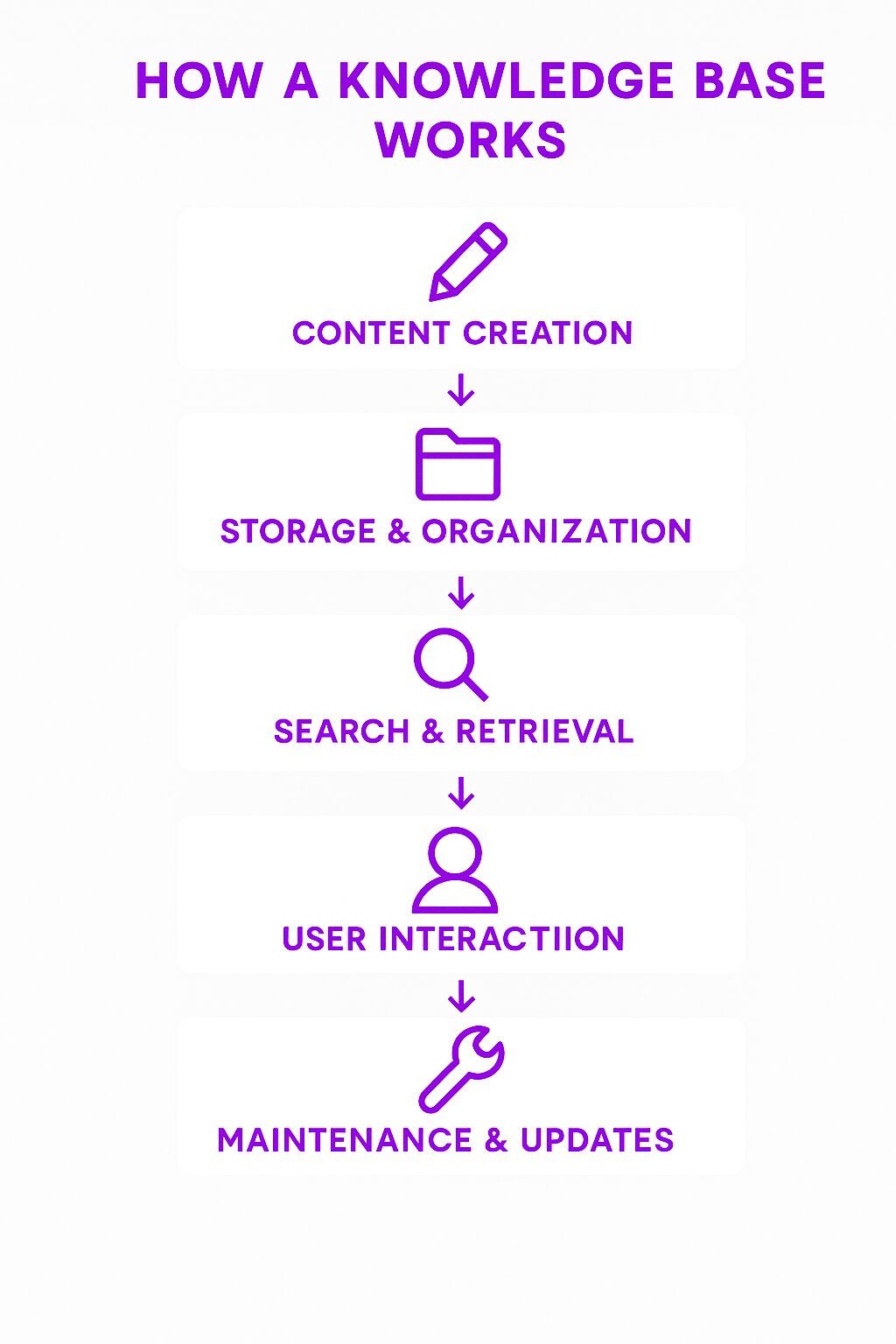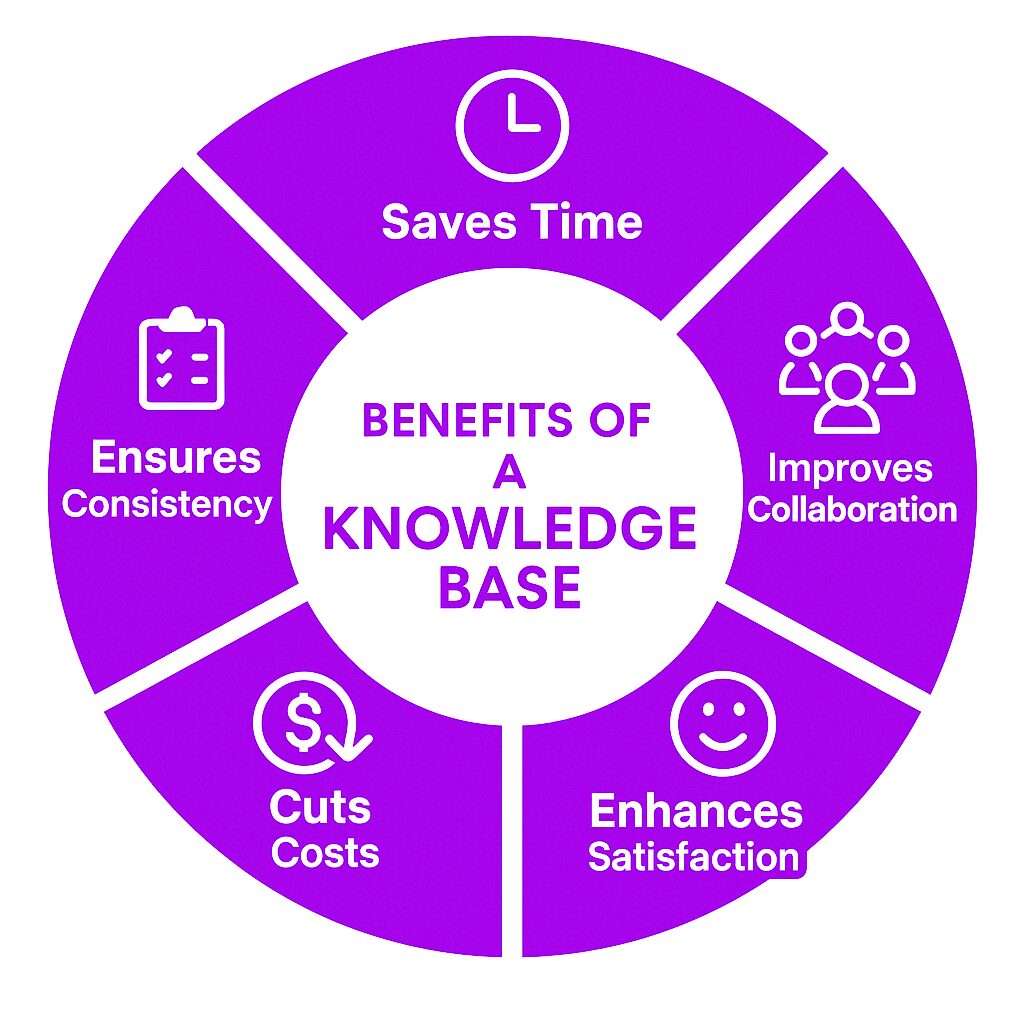What is a Knowledge Base?
A knowledge base is a centralized repository that stores and organizes information for easy access. It allows employees, customers, or users to find answers to common questions, reference company policies, and troubleshoot problems without needing direct assistance. Companies use knowledge bases to improve productivity, streamline support processes, and retain institutional knowledge.
A well-structured knowledge base reduces the need for repetitive explanations and makes information easily accessible. It can be internal, helping employees work more efficiently, or external, providing customers with self-service solutions. A customer facing knowledge base provides customers with self-service solutions and improves customer satisfaction by allowing them to find answers and resolve issues independently. Additionally, a customer service knowledge base serves as a repository for support-related information, such as FAQs and troubleshooting guides.
Types of Knowledge Bases
1. Internal Knowledge Base
An internal knowledge base is a centralized repository of information that is accessible only to employees within an organization. It is designed to store, organize, and share company knowledge, policies, procedures, and best practices to improve internal processes, productivity, and collaboration. By providing a single source of truth, an internal knowledge base ensures that employees have access to up-to-date information, reducing the need for repetitive explanations and fostering a culture of knowledge sharing. This type of knowledge base is crucial for onboarding new employees, streamlining internal communication, and preserving institutional knowledge, ultimately enhancing overall efficiency and productivity within the company.
How Knowledge Base Software Works
A knowledge base functions as a structured collection of documents, FAQs, guides, and troubleshooting information. Content is organized in categories, indexed for easy searching, and often includes features like:
-
Search functionality
-
AI-powered recommendations
-
Role-based access control
-
Integration with chatbots and help desks
Effective knowledge base software enhances customer support and self-service by providing quick access to information. Many companies use cloud-based knowledge bases to allow real-time updates, ensuring employees and customers always have access to the latest information.
Key Components of a Knowledge Base
1. Content Creation
A knowledge base starts with the knowledge management process, which involves collecting information relevant to users. This includes policies, FAQs, troubleshooting guides, and procedural documentation.
2. Storage & Organization
Information is categorized and tagged to ensure quick retrieval. Proper structure prevents clutter and makes navigation intuitive.
3. Searchability & Accessibility
A good knowledge base has an optimized search function, allowing users to find answers quickly. An external knowledge base is a public resource designed for customers to access information about a company’s products and services. Features like AI-driven search and natural language processing enhance the user experience.
4. User Interaction
Some knowledge bases allow users to comment on or rate articles, ensuring continuous improvement based on feedback.
5. Maintenance & Updates
Regular updates are crucial to manage knowledge effectively, preventing outdated information from leading to confusion. Organizations must assign ownership to ensure content remains accurate and relevant.
Why a Knowledge Base is Important
A knowledge base centralizes information, reducing dependency on emails, meetings, and one-on-one training. It enhances efficiency by ensuring employees and customers can find answers on their own.
Key benefits include:
-
Faster issue resolution
-
Reduced support tickets
-
Improved employee onboarding
-
Consistency in information sharing
-
Increased customer satisfaction through self-service options
Implementing an effective customer self service knowledge base can significantly enhance the customer experience by providing quick solutions and reducing the need for direct agent interaction.
Benefits of a Knowledge Base
1. Saves Time
Employees and customers don’t have to wait for responses to common questions. A searchable database provides instant answers.
2. Improves Collaboration
Teams can document and share best practices, ensuring institutional knowledge is preserved even when employees leave.
Enhances Customer Satisfaction
Customers prefer self-service solutions over waiting for support responses. A well-maintained knowledge base improves user satisfaction.
4. Reduces Operational Costs
Support teams spend less time on repetitive inquiries, allowing them to focus on more complex issues. By providing resources like knowledge bases and FAQs, customers can find solutions independently, which ultimately supports the efforts of the support team and enhances overall customer satisfaction.
5. Ensures Consistency
Having a single source of truth ensures that employees and customers receive the same accurate information.
Challenges of a Knowledge Base
1. Initial Setup Effort
Building a knowledge base requires significant upfront effort in gathering, organizing, and structuring content.
2. Keeping Content Updated
Outdated information can mislead users. Organizations must regularly review and refresh content.
3. User Adoption
Employees and customers need to be encouraged to use the knowledge base instead of relying on direct support. Internal knowledge bases play a crucial role in enhancing productivity, efficiency, communication, and knowledge sharing among employees.
4. Content Quality
Poorly written or unstructured articles can frustrate users. Content should be clear, concise, and easy to navigate.
Best Practices for Managing a Knowledge Base
1. Structure Content Logically
Use categories, tags, and a clean layout to make navigation simple.
2. Use a Powerful Search Function
An AI-driven search feature helps users find relevant articles without frustration.
3. Encourage Employee Contributions
Subject matter experts should contribute content to ensure accuracy and relevance.
4. Monitor and Update Regularly
Set up a review cycle to refresh outdated information and remove redundant content.
5. Analyze Usage Data
Tracking search queries and user feedback can help identify gaps and improve content over time.
6. Integrate with Other Systems
Linking a knowledge base to a help desk, chatbot, or internal communication tools improves accessibility. There are various types of knowledge base systems, categorized into five main types, each with diverse applications and functions.
Related Concepts
1. Knowledge Management Systems (KMS)
Broader frameworks that manage organizational knowledge beyond a knowledge base.
2. Self-Service Portals
Web-based platforms where customers can resolve their queries without contacting support.
3. AI-Powered Knowledge Bases
Using machine learning to suggest articles and automate responses based on user queries.
Real-World Use Cases
1. Customer Support Centers
A telecom company reduces call center volume by equipping customer support teams with the necessary information to improve their response times and effectively assist customers, while also directing users to a self-service FAQ portal.
2. Employee Onboarding
A corporate intranet includes a knowledge base with training materials, reducing onboarding time for new hires.
3. IT Help Desks
An IT department maintains troubleshooting guides for common technical issues, minimizing support tickets.
4. E-commerce Platforms
Online retailers use knowledge bases to provide product information and return policies, improving customer satisfaction.
The Future of Knowledge Bases
Advancements in AI and automation will make knowledge bases more interactive and efficient. Predictive search, voice-enabled queries, and chatbots integrated with knowledge bases will further enhance self-service options. Organizations that invest in a well-structured knowledge base will see long-term benefits in productivity, customer support, and employee engagement.







